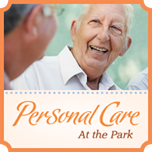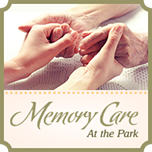Many people live here from many different walks of life. We have 146 apartments. Currently we have 168 residents. I have residents that still work full time. We have residents that are retired, some are semi-retired. We have snowbirds! Folks that own homes down the south, South Carolina – Florida, that will leave us when the winter comes. And turn around, lock the apartment, and we won’t see them for 3 or 4 months until the weather breaks. So we have husband and wives that live here, single folks, a few mothers and their daughters that live here. So it’s a whole smattering of different types of people that live with us, and I think that’s the most exciting part. People from all different walks of life, like I say, folks that are semi-retired, fully retired, still working all living in the same community, but all enjoying being together and enjoying living under one roof.
Larry Taylor
Administrator at The Farms
Some of the nice features of living in a community like gloria Dei Farms is, not only the fact that we have wonderful, large 1 and 2 bedroom apartments or 2 bedrooms with a den, so the apartments are wonderful, but outside your apartment door the amenities we offer: we have a 14 passenger bus that we use to take our residents, no charge, grocery shopping, we go to the local convenience stores such as Wal-Mart, we’ll do mall trips, we’ll go to the local malls for shopping. That’s just one of the few perks that you have living here in a community.
All of our apartments have the asher and dryer hook ups in them. so you have your own laundry room right inside your own apartment, which is nice. There’s extra storage. Every apartment gets a small storage area in our storage location, which is great for storing Christmas items, suitcases, and large items that you really don’t want to tie up space in your apartment. So they’re features that come with each Gloria Dei apartment. We are completely secure, as far as our entrances are all videotaped and monitored 24 hours a day.
We have a key fab system for security so no one can enter the building unless they have the electronic key that each resident is given. It gives you peace of mind, security, when you walk in our doors, once that door shuts behind you, no one is coming in unless we know about it. And that’s huge, because we all look for security in our lives. These are just simple things we do in our communities to make people feel safe and secure.
Larry Taylor
Administrator at The Farms
As you age, you might notice that your skin becomes a little less elastic and a little drier. This is quite common. It’s why we get more wrinkles as we get older. Unfortunately, there are also chronic conditions that come with our aging skin as well. One of these conditions is known as psoriasis.
If you’re unaware of psoriasis or the effects that it has on an individual’s skin, that means you must NOT be a part of the nearly 80 million people who has the disease. It’s a long lasting autoimmune disease, which means your immune system attacks a normal part of your body. In this instance, it’s your skin. This disease leaves patches of red, itchy, and scaly skin. It’s uncomfortable and unsightly. Unfortunately, there is no cure for it, but there are plenty of lifestyle choices you can make to keep these attacks under control.
There are 5 different types of psoriasis. However, only one type appears much more frequently than the other four. The most common type, plaque psoriasis, will be the focus of this article. Of all the people who are affected by this skin disease, 90% of them are have plaque psoriasis. It’s the most common and most treatable. Below are some tips to try and prevent flare-ups or control them better when they do occur.
Ways to Prevent Flare-Ups
Reduce Stress – Stress is a major factor when dealing with the strength of our immune system. It can severely weaken it. Also, our bodies tend to have an inflammatory reaction to stress. This will not help your chances in preventing psoriasis. It’s important to reduce the amount stress in all aspects of your life. Yoga and meditation are great ways to help. These two activities promote relaxation of the mind and body. Two key factors when it comes to stress and psoriasis. Not to mention, yoga is great for your muscles and joints!
Prevent Skin Injuries – Injuries to the skin can also cause flare-ups of psoriasis. These injuries can include minor scrapes and scratches, as well as a sunburn. This is due to the Koebner phenomenon, a reaction that causes new psoriasis plaques to form wherever you experience a skin infection or injury. That’s why, if you suffer from psoriasis, it’s a good idea to take precaution when going to do some sort of outdoor activity. Always make sure you’re wearing sunscreen and if you’re going to do some gardening, wear gloves and a long sleeve shirt. This will prevent any minor scraps or other forms of skin irritation from turning into a psoriasis outbreak.
Maintain a Healthy Diet – Being overweight does not help when it comes to psoriasis. There are a lot of health issues that come from being obese. Poor psoriasis management is one of them. There are also certain types of foods that seem to cause inflammation, as well. These include red meats, high-fat foods, processed foods, and refined sugars. It’s unfortunate, but a lot of the easy meals you can prepare quickly are not good for your skin. However, there are foods that you can eat that help prevent psoriasis from flaring-up. These foods are fatty fish, almonds, and leafy vegetables. All of these foods help prevent inflammation which leads to a decreased chance of a flare-up.
Still See Your Doctor
Unfortunately reducing stress, preventing skin injuries, and maintaining a healthy diet will not eliminate psoriasis all together. You will still see that familiar rash on your skin from time to time. That’s why it’s always best to see your doctor regularly. He or she, with advice regarding specific lifestyle choices, can also prescribe medicines and ointments to end flare-ups. If you do these two things this month, you’ll be celebrating Psoriasis Awareness Month the right way!
The summer is the perfect time to get out and be active. There are plenty of things to do when the days are longer and warmer. In fact, if you want some ideas, you can read our latest blog here. However, it’s also important to monitor your body temperature and your hydration level, while you’re doing all of these activities. Grant it, there’s no need to walk around with a personal thermometer and take your temperature every ten minutes. But, it is a good idea to follow some of these tips below in order to avoid some form of illness due to dehydration or heat stroke.
Stay Hydrated
The most important thing to do in hot summer days is to stay hydrated. However, as we age, our bodies don’t recognize right away how thirsty we are. Therefore, it’s pretty common to fall victim of dehydration without even noticing it. That’s why it’s a good idea to consume up to eight 8-ounce glasses of water a day. This may seem like a lot, but the idea is to constantly be drinking throughout the day. That way you won’t feel overly full, and you’ll be constantly hydrated. Just make sure you’re avoiding caffeinated and alcoholic beverages, because they will actually add to your dehydration.
Wear the Right Clothes
What you wear greatly prepares you for the weather you’re facing. Obviously, in the winter, heavier clothes help your body temperature from dropping too low. On the other hand, during the summer, the idea is to wear loose fitting clothes so your body can circulate cold and hot air better. It’s also a good idea to wear lighter colored clothes. This reflects light, as opposed to absorbing it like darker colors. By reflecting more light, you’re able to better control your body temperature.
Watch for the Midday Sun
The time of day matters when you’re going out and doing your errands or favorite activities. The sun is the hottest when it’s the afternoon. That’s why it’s best, if you can, to put off your errands for the early evening or do them in the morning before the sun reaches its highest point. If you want to perform one of your favorite physical activities, it’s best to wait until the evening. That way the sun will be setting, and you can expect to experience some cooler temperatures.
Apply Sunscreen
It’s also a good idea to protect your skin during hotter days. If you do plan on heading outdoors during the afternoon, make sure you apply sunscreen with an SPF of at least 15. This will reduce your chances of getting sunburned and keep your skin from being damaged. You can also wear a wide-brimmed hat and sunglasses. These accessories will protect your head and your eyes from getting damaged by the sun.
Know the Warning Signs
The final tip to take note of includes the warning signs for heat stroke. Even if you take advantage of all of the information above, it’s still very crucial that you know the warning signs if you ever happen to suffer from dehydration and/or heat exhaustion. These symptoms include flushed face, high body temperature, headache, nausea, rapid pulse, dizziness, and confusion. If you’re experiencing any one of these symptoms it’s important to seek medical attention as soon as possible.
Enjoy the Summer
Heat exhaustion and heat stroke are no joke. However, don’t let it make you fearful of going outside and enjoying the activities you like to do in the summer. Your best bet is to follow the tips above. Just make sure you’re hydrated, comfortable, and protected from the sun, and you’ll be on your way to enjoying this beautiful season!
Our mother was in Personal Care and Memory Care at The Park for a number of years. We always felt she was in a great place and well taken care of.
Thank you, Bev and John Deal
June 21st is when you can officially state that summer has started. However, that doesn’t mean you can’t get outside and enjoy this fine weather now. In fact, it’s better if you start taking advantage of the higher temperatures and spend some time in the sun! But you don’t have to just stand outside and collect the rays. There are a lot of fun activities you can do this season, especially now, as the days grow warmer and longer. Below is a list of activities you can do close to home or enjoy around your town or city as you get out and explore!
Gardening
Find your green thumb! Maybe you used to be an expert gardener or you’re starting out as a novice; either way, gardening is an excellent activity for seniors to enjoy in the summer months. It helps you get outside, soak up some sun, and keeps the joints active as you bend and crouch to tend to your plants. It’s also a great form of self-satisfaction. Watching your plants grow is like finishing a work of art. The time and dedication you put into leaves you feeling with an incredible sense of accomplishment. As it should! This in turn helps boost your mood and lowers one’s chances of having depression.
Community Events
Attending events in your town or city is an excellent way to feel connected to your community. Not only do these events help you get out and about, but they also give you a sense of belonging. Some examples of community events include:
- Museum Events – You can check out the latest exhibits on display, or go see a new art gallery that’s being shown. Not to mention, many museums have their own activity calendars and their own events. Keep an eye out and see what’s going on week to week!
- Local Sports Game – Cheer with the home crowd! If you really want to feel like you belong with your local community, there’s nothing like participating in chants and ovations for your favorite team. You can go see a professional team or even your grandchild’s little league game! Sports are always fun to enjoy with the people around you.
- Farmers Market – Picking out some fresh fruits and vegetables at your local farmers market is a great way to get out and get moving. Not to mention, it’s an excellent way to eat healthy! As the saying goes, you’ll be killing two birds with one stone when it comes to healthy living.
- Movie Theater – There are many communities that offer special outdoor movie nights during the summer months. You can also enjoy a movie if it is an especially hot afternoon, which is great because often times ticket prices are cheaper for afternoon matinees. However, you can also organize your own movie night and get together with some friends to enjoy a movie that you all might like.
- Music Venue – Who doesn’t love hearing live music?! If the opportunity ever arises, get out to a local music venue and hear some tunes. Make sure you’re checking the activity calendars of local venues to see if a show you’d really enjoy is coming up.
Take a Walk
It’s always good to try and work in some cardio while you’re enjoying your summer activities. It helps strengthen muscles and improves your heart health. If a walk is possible, it’s best to start slow and then eventually work up to longer outings. This will improve your endurance and lessen your chances of a debilitating fall. Just think of these strolls as sightseeing with an added bonus!
Be a Tourist
This is a much easier task if you live around a city, because there are many things you can do, such as taking an open-air bus to the local sights or even a boat tour if you live by the water. The reason these activities are so great is because it gets you both outside, but you don’t necessarily have to be walking if mobility is an issue.
If you don’t live by a major city, you can just go for a Sunday drive around town. This allows for you to check out all of the happenings in the community. Or you can simply reconnect with a town or city you haven’t visited in a while. You can see all of the new construction, blooming flowers and trees, or even festivals and community events that may be going on at that time.
Treat Yourself
If you have a favorite snack or restaurant that picks your spirits right up, plan a trip to visit it in the near future. Instead of limiting this indulgence to a special occasion, make it an outing with all of your friends. This could consist of getting an ice cream cone from a local shop, a pastry from your favorite breakfast spot, or a lunch special from the diner around the corner. Don’t hold back!
The month of May is a wonderful reminder that summer is on its way and that the nice weather is here to stay. For some people, that means getting outside to do some gardening, going on a bike ride, or maybe extra walks during the week. Nice weather tends to make us more active.
Unfortunately, for those who suffer from arthritis, bending down to tend to a plant or even gripping a gardening tool seems like a near impossible task. You can certainly forget about peddling a bike or going on those extra walks. Arthritis is a debilitating disease that can deter anyone from remaining active. Luckily, the month of May is not only a fresh reminder of the beautiful weather to come, but also that your arthritis does not have to control your life. This May, make sure you’re celebrating National Arthritis Awareness Month the right way! Find out how you can reduce and relieve your symptoms and remain moving in May and the many months to come.
Types of Arthritis
Before you begin to read about relief techniques from arthritis, it’s important to know the different types of it. Some forms of arthritis are more serious than others and may require prescription medicine or greater procedures to ease the pain. Other forms of arthritis can be soothed by more holistic approaches. As always, it’s important to talk to your primary physician to see what approach would work best for you.
Osteoarthritis (OA)
This form of arthritis involves the breakdown of your protective cartilage inside and around your joint. As a result, movement of the affected joint or joints becomes more difficult and painful. The purpose of cartilage is to add an extra layer of cushion for your bones. Without it, our bones would constantly rub against each, causing a great deal of pain. Unfortunately, this is what OA does to us. It prohibits the amount of movement that goes on within our joints, because it destroys the cartilage surrounding it. The intensity of OA pain varies from person to person and can range from mild to severe.
Rheumatoid Arthritis (RA)
Our immune systems are meant to protect our bodies from incoming attacks from bacteria and viruses. Unfortunately with RA, our immune systems actually attack our own bodies. This is called an autoimmune disease. In the case of RA, the immune system primarily goes after the lining of the joints, called the synovium. Over time, the persistent inflammation breaks down the joint and damages it permanently.
Psoriatic Arthritis (PsA)
PsA is another autoimmune inflammatory disease like RA. However, not only are the joints affected with this disease but the skin is, too. Unfortunately, 15% to 25% of patients who have psoriasis, a skin disorder that includes patchy, raised, red areas of skin inflammation with scaling, also develop an associated inflammation in their joints.
Gout
Gout is also a form of inflammatory arthritis, however it does not cause body-wide inflammation like RA or PsA does. With this disease your body produces too much uric acid or you’re body is unable to remove the excess fast enough. This can cause a build up in the blood. This excess of uric acid can then form crystals in your joints. As a result, an extreme pain can be felt in the joint due to inflammation. Gout usually strikes in the large joint of the big toe, but can also affect other joints.
So now that you know about some of the various types of arthritis, it’s time to learn how to curb their symptoms.
Reducing Symptoms
Lose Weight
Your weight can significantly affect the health of your joints. As you can see from the information above, a lot of the pain from arthritis is due to inflammation. Having extra weight is only going to apply more pressure to your joints that are flaring up from this inflammation. This excess just puts your knees, hips, ankles, etc. under greater duress. That’s why it’s important to remain active even when experiencing some form of arthritis. Losing extra weight or maintaining right where you need to be will increase your mobility, reduce your chances of greater pain, and prevent future damage.
Exercise Regularly
There is a myth floating around that states exercise and arthritis do not go hand in hand. This is flat out false. The more you exercise the more flexible your joints become. It also helps your weight-bearing muscles become stronger. That way when you’re walking or standing during everyday scenarios, the pain you feel will be greatly reduced.
Hot and Cold Therapy
There’s nothing like a nice warm shower in the morning, especially if you have arthritis pain. Simple hot treatments can make a world of difference. Long, warm showers or baths help ease stiffness in your joints. This increases the mobility within the joints and helps to reduce pain. You can also utilize an electric blanket or moist heating pad at night to keep your joints loose.
Cold treatments are best for relieving joint swelling and inflammation. If you notice your knee or knuckles swelling up from being active during the day, you can wrap a gel ice pack or a bag of ice in a towel and apply it to painful joints. This will provide some quick relief and reduce some of the swelling going on inside of your joints.
Use Medication
Over-the-counter pain medications such as Tylenol, Advil, or Motrin can help relieve occasional pain triggered by activity your muscles and joints aren’t used to. This is to help provide quick relief without having to constantly apply ice or stop everything you’re doing to take a shower or bath. However, it’s important to understand the recommended amount to take. For pills such as Tylenol, where acetaminophen is the main active ingredient, taking too much could result in liver damage. Consult with your doctor to determine the proper amount to take!
Our view of Alzheimer’s disease and the way it’s treated have been changing since it was first discovered in 1906. To stay on top of some of the newest facts and figures, read our list of 7 essential facts about Alzheimer’s disease.
- Dementia is not synonymous with Alzheimer’s disease.
- About 5.4 million Americans have the disease and may not know they have it.
- It’s the 6th leading cause of death in the US.
- Half of adults aged 85 and over have Alzheimer’s.
- More women have Alzheimer’s than men.
- You can reduce your risk factors for getting Alzheimer’s.
- There is still no cure.
A lot of people try and use these terms to describe the same thing. This is not accurate. Alzheimer’s disease is a specific type of dementia, while dementia is just an umbrella term to describe a decline in mental ability. It is not a disease itself. It’s used to categorize a number of symptoms that involve a decline in cognitive ability. It includes diseases such as Alzheimer’s or even vascular dementia that may occur after a stroke.
This fact speaks to the difficulty in diagnosing the disease. Early stages of Alzheimer’s can simply come off as though your memory is just getting a little foggy. Even with blood tests and brain scans it’s tough to diagnose. Therefore, about half of the people estimated to have the disease, don’t know they have it.
This fact is both good news and bad news all in one. It’s good because scientists and researchers alike are improving treatment when it comes to conditions like heart disease and cancer. The death rate for those diseases are beginning to decline. Unfortunately, Alzheimer’s still has no cure and no possible treatment options to reverse its effects. As a result, we might see it climb even higher.
This disease has truly become an epidemic amongst older adults in the US and around the world. It’s the most common type of dementia and will remain that way until a cure is found.
According to a report done by the Alzheimer’s Association, nearly two-thirds of Americans suffering from Alzheimer’s are women. However, don’t let this statistic fool you. This does not mean there is a gender-based predisposition for the disease. Alzheimer’s does not care about your sex or ethnicity. The only reason for this statistic is that women generally live longer than men.
Sadly you cannot reduce your chances of getting Alzheimer’s to zero. However, you can still reduce your risk. There are specific lifestyle choices you can make that will aid in the defense of your healthy brain as you age. These lifestyle choices include your diet, consumption of alcohol, smoking, and other various choices you can make that promote a healthier lifestyle.
It seems, time and time again, we hear uplifting news about a possible cure for Alzheimer’s, only to see it fail during a more rigorous form of clinical trial. We are still in search of a cure. Remember that Alzheimer’s disease is not a normal part of aging, and we shouldn’t accept it as that. There are ways to reduce our chances of getting it and even slowing down its progression, but we cannot cure it yet. We still need to hold onto hope for one and help out those in search of a cure anyway we can.











